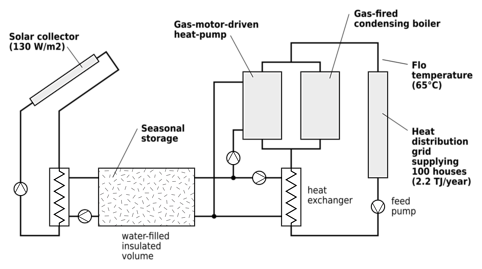Hi @danielschwab I was earlier involved in modeling municipal systems. The software used, now long defunct, was called deeco and resides on GitHub for historical reasons. You will be pleased to hear that there was a single electricity bus and no power flow model. But the reason I mention the project is that thermal systems were captured with quite some technical integrity yet could also be subject to convex optimization. See in particular, Morrison (2000) on thermal sub‑networks, §8.6 (p146–150) and figure 8.1 (p121) in this regard.
The reason I added quite a number of references below is that “heat” supply has dropped off the modelling radar lately to some extent. Back then though, batteries were expensive and limited and seasonal storage using hot water was quite in vogue.
In addition, Bruckner et al (1997) was the first paper (to my knowledge) that introduced the idea of having to navigate the various counteractions and synergies in these kind of systems. Prior to that, the various sub‑systems were assumed to operate without spill‑over effects like these.
Finally, deeco is licensed GPL‑2.0 but you are unlikely to get the code to build and run. If you need more technical background, I have some unpublished manuals. HTH.
Source: Lindenberger et al (2000). CC‑BY‑4.0 license (here).
References
Bruckner, Thomas, Helmuth-M Groscurth, and Reiner Kümmel (1997). “Competition and synergy between energy technologies in municipal energy systems”. Energy. 22 (10): 1005–1014. ISSN 0360-5442. doi:10.1016/S0360-5442(97)00037-6.
Bruckner, Thomas, Robbie Morrison, and Tobias Wittmann (2005). “Public policy modeling of distributed energy technologies: strategies, attributes, and challenges”. Ecological Economics. 54 (2–3): 328–245. ISSN 0921-8009. doi:10.1016/j.ecolecon.2004.12.032.
Bruckner, Thomas, Robbie Morrison, Chris Handley, and Murray Patterson (2003). “High-resolution modeling of energy-services supply systems using ‘‘deeco’’: overview and application to policy development”. Annals of Operations Research. 121 (1–4): 151–180. doi:10.1023/A:1023359303704.
Lindenberger, Dietmar, Thomas Bruckner, Helmuth-M Groscurth, and Reiner Kümmel (2000). “Optimization of solar district heating systems: seasonal storage, heat pumps, and cogeneration”. Energy. 25 (7): 591–608. doi:10.1016/S0360-5442(99)00082-1.
Lindenberger, Dietmar, Thomas Bruckner, Robbie Morrison, Helmuth-M Groscurth, and Reiner Kümmel (2004). “Modernization of local energy systems”. Energy. 29 (2): 245–256. ISSN 0360-5442. doi:10.1016/S0360-5442(03)00063-X.
Morrison, Robbie (2000). Optimizing exergy-services supply networks for sustainability — MSc thesis. Dunedin, New Zealand: Physics Department, Otago University.

